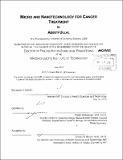| dc.contributor.advisor | Ralph Weissleder. | en_US |
| dc.contributor.author | Ullal, Adeeti (Adeeti Vedantham) | en_US |
| dc.contributor.other | Harvard--MIT Program in Health Sciences and Technology. | en_US |
| dc.date.accessioned | 2014-01-14T15:25:40Z | |
| dc.date.available | 2014-01-14T15:25:40Z | |
| dc.date.issued | 2013 | en_US |
| dc.identifier.uri | http://hdl.handle.net/1721.1/83968 | |
| dc.description | Thesis (Ph. D. in Biomedical Engineering)--Harvard-MIT Program in Health Sciences and Technology, 2013. | en_US |
| dc.description | Cataloged from PDF version of thesis. | en_US |
| dc.description | Includes bibliographical references (pages 92-101). | en_US |
| dc.description.abstract | Cancer is responsible for over 7.6 million deaths worldwide; the majority of patients fail to respond to drugs or become resistant over time. In order to gain a better understanding of drug efficacy in patients, we developed three diagnostic technologies to address limitations in sample acquisition and improve the scale and sensitivity of current cancer diagnostic tools. In the first section, we describe a hybrid magnetic and size sorting microfluidic device that isolates rare circulating tumor cells from peripheral blood. The self-assembled magnetic sorter creates strong magnetic fields and effectively removes leukocytes tagged with magnetic nanoparticles. The size sorting region retains the remaining cells in single cell capture sites, while allowing small red blood cells to pass through 5pm gaps. The device achieves over 103 enrichment, up to 96% recovery of cancer cells and allows for on-chip molecular profiling. In the second section we use a magnetic nanoparticle decorated with small molecule drugs to assay target expression and drug binding in mock clinical samples of cancer cells spiked into whole blood. Specifically, we modify a PARP inhibitor (Olabarib) and conjugate it to a dextran coated iron oxide nanoparticle. We measure the presence of the drug nanosensor based on the change in T2 relaxation time using a miniaturized, handheld NMR sensor for point-of-care diagnosis. In the final section, we detail a photocleavable DNA barcoding method for understanding treatment response via multiplexed profiling of cancer cells. We validate our method with a 94 marker panel on different cell lines with varying treatments, showing high correlations to gold standard methods such as immunofluorescence and flow cytometry. Furthermore, we demonstrate single cell sensitivity, and identify a number of expected biomarkers in response to cell treatments. Finally, we demonstrate the potential of our method to help in clinical monitoring of patients by examining intra- and inter-patient heterogeneity, and by correlating pre and post-treatment tumor profiles to patient response. Together, we show how these technologies can help overcome clinical limitations and expedite advancements in cancer treatment. | en_US |
| dc.description.statementofresponsibility | by Adeeti Ullal | en_US |
| dc.format.extent | 101 pages | en_US |
| dc.language.iso | eng | en_US |
| dc.publisher | Massachusetts Institute of Technology | en_US |
| dc.rights | M.I.T. theses are protected by
copyright. They may be viewed from this source for any purpose, but
reproduction or distribution in any format is prohibited without written
permission. See provided URL for inquiries about permission. | en_US |
| dc.rights.uri | http://dspace.mit.edu/handle/1721.1/7582 | en_US |
| dc.subject | Harvard--MIT Program in Health Sciences and Technology. | en_US |
| dc.title | Micro and nanotechnology for cancer treatment | en_US |
| dc.type | Thesis | en_US |
| dc.description.degree | Ph.D.in Biomedical Engineering | en_US |
| dc.contributor.department | Harvard University--MIT Division of Health Sciences and Technology | |
| dc.identifier.oclc | 863155142 | en_US |
